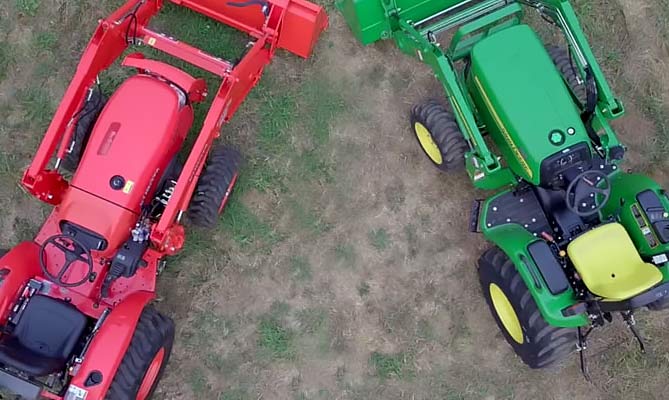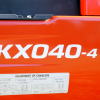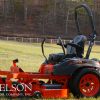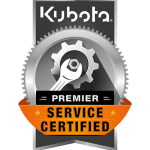Kubota and John Deere, as brands, are both leaders among farm and construction equipment manufacturers. When you compare Kubota to John Deere, a lot will be equal or so close that it doesn’t matter. What does matter is quality construction, longevity, service options, price, and how each of these fits into your property. Every property and construction job are different, but the equipment is too. One brand may suit your needs much better than another, which is the point of this post.
Misconceptions of Kubota vs. Deere
One of the biggest misconceptions about Kubota is that they are of poor quality construction. The reality is that Kubota has been building quality tractors since they began. Used Kubota tractors hold their value, and for a good reason. Many Kubota tractors pull in hard work for 4,500-5,500 hours, and when you care for your Kubota, you could potentially see workloads in the 8,000+ hour range. Those are not traits of cheaply constructed equipment. [1]
Another myth that we hear a lot about Kubota is that it becomes impossible to find parts for used Kubota equipment and older models specifically. We’re happy to let you know that Kubota has perhaps the best options for available parts for new, gently used, and old workhorse tractors across all brands. That also includes access to manuals for older tractors and equipment too.
Where does Kubota shine, and where is Deere weak?
For most of us, the better tractor or equipment comes down to specific needs and job types.
Both John Deere and Kubota have strengths and weaknesses, and neither brand has the “perfect” tractor. In that light, here are some features that make Kubota shine.
- SSQA — Skid Steer Quick Attach — attachment option – the standard is the Quick Attach (QA) pin system, but you can opt for an SSQA.
- Factory Cab on Smaller Units— Kubota offers factory cabs on their two series tractors. The full enclosure makes working in challenging environmental conditions much more manageable. A factory cab is not available at JD on two series – Not only do you get a comfortable cabin, but there are also full climate controls with AC and heat. In addition, there is an option for a radio/stereo. The Kubota factory cab has both front and rear wipers. You should sit in one of the tractors with a factory cab and feel the comfort. Kubota offers these cabs on smaller tractors, whereas John Deere does not. The Kubota Factory Cab is a huge plus if you have year-round farm chores that require a smaller tractor. It keeps you out of the heat, wind, dust, rain, sleet, and snow while providing a climate-controlled environment that makes tractor work much more enjoyable. When comparing Kubota vs. John Deere compact tractors, Kubota has the edge.
3 Quick Park Loader – is standard on all Kubota models, including the entry BX models. If you want a Quick Park Loader on John Deere equipment, they are optional. When you need to change loading functions quickly, then the Quick Park Loader is a fantastic option.
4.Medium Range Drive available on Entry Level Equipment. On a John Deere, you have high or low and neutral for smaller equipment and a medium drive on larger deluxe equipment. Having a medium drive option allows you to choose how you approach jobs that require a tractor. What you gain is faster speed, and you lose some high-end torque with medium drive. Because not every job requires high-end torque, you can get some work done faster by employing the medium-range drive. That added value gives Kubota a better fit for some chores over John Deere, especially when using smaller equipment.
What is the Draw When Buying a Tractor?
Much of the draw is brand loyalty. We tend to gravitate to proven brands we recognize, and John Deere is a brand most everyone knows. Kubota is a quality brand, and the two hold the top positions across all tractors and farm equipment brands. That’s a key reason to look at what you need a piece of equipment to do rather than who makes it. You will find subtle differences between these two brands, and those differences, such as having a medium drive on smaller equipment, make farm and construction work much more manageable.
What are some examples of the strengths and weaknesses when you compare specific models in each brand?
- Compact Tractors – Kubota L series vs. John Deere 3E Series — One big difference is the medium range drive as a standard on Kubota.
- Another feature is the Quick Mount Loader feature on Kubota L Series which detaches in minutes.
- The John Deere 3D series has a Fixed-Mount Loader which requires tools and time to remove it.
Zero Turn Mowers
You notice several things if you look closely at Kubota vs. John Deere Residential Mowers. Here, we compare the Kubota Z231 and the John Deere Z355E. First is the pricing. The John Deere Z355E enters the market around $3,500 and the Kubota Z231 at $3,999. A difference of about $500 in savings for the Deere over the Kubota Z231. If you are only shopping by price point, you are likely excited about the John Deere Z355E.
But, Take a closer look at the manufacturing.
The two Zero-Turn mowers are different. The Kubota is slightly larger at 749 pounds, while the Deere Z355E weighs 555 pounds; The difference is partially due to the heavier build of the Kubota. Visually, that difference is easy to spot. John Deere uses a spot welding technique to put their mowers together. Kubota is fully welded. Even the frame steel is thicker on the Kubota.
Another difference is the seat. The John Deere seat is one piece, and while the Z355E has a comfort system, the seatback is low. The Kubota Z231 has a taller seat with a two-part unit that adjusts to fit the seat to your body. That makes a difference for long days mowing or working on the farm.
Quality built — Starting with the wheels, Kubota offers bearing style adjustments for the front wheel casters, while the John Deere uses a thin rubber bushing.
It is often the little things that make up huge differences. Overall, you find that the John Deere Z355E, which is a good zero-turn mower, has a weaker construction and falls slightly shorter on user experience than the Kubota Z231. The last benefit of looking at Kubota is their zero-down financing available for all of their products.
See how five of the top Kubota zero turn mowers compare with each other.
The Breakdown
Comparing Kubota vs. Deere is tough because both these brands are leaders, and there are many similarities. Kubota put a lot of thought into the construction of its equipment and tools, which is the starting point of older John Deere products. Some newer John Deere models feel thinner, and that is something you can experience for yourself simply by looking at both product lines.
The Kubota Brand also considers your time and builds in features that help you work more efficiently — standard quick-release loaders, etc. Kubota also considers environmental conditions, and with options like Factory Cabs on smaller models, you gain a more comfortable working environment. Even with riding mowers and zero-turn mowers, some differences impact job performance.
When shopping for a tractor, mower, or farm equipment, the best advice is to sit in the driver’s seat and feel the differences. For us, those differences put Kubota ahead of John Deere.
Sources: Kubota Brochure









